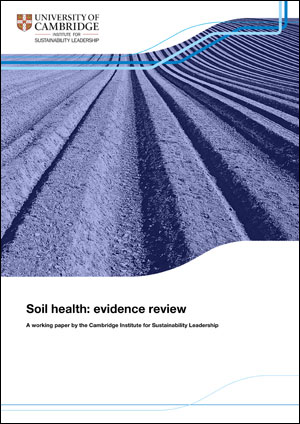July 2017 – Many leading food and beverage sector organisations have demonstrated progress in managing natural capital impacts in their direct operations, including greenhouse gas emissions and waste. Many recognise, however, that the largest impacts occur in their upstream value chains, particularly on farms where raw materials are produced. A key natural capital resource is soil, and managing soil health is one way in which businesses may be able to reduce their negative land use impacts.
Publication date
July 2017
 This report addresses the issue of how businesses that depend on healthy soil may best demonstrate and hence manage their impacts. It recommends the development of a soil metric using a conceptual model that combines both a measurement of inherent soil quality as well as a measurement of land use type/ intensity. Such a metric is intended to readily demonstrate the effects that any changes in land use practices may be having on soil health, be they positive or negative.
This report addresses the issue of how businesses that depend on healthy soil may best demonstrate and hence manage their impacts. It recommends the development of a soil metric using a conceptual model that combines both a measurement of inherent soil quality as well as a measurement of land use type/ intensity. Such a metric is intended to readily demonstrate the effects that any changes in land use practices may be having on soil health, be they positive or negative.
Proposed next steps
- Businesses adopt a consistent definition of soil health.
- Devise a strategy for developing metrics that includes the conceptual model proposed in this report.
- Investigate the value of using soil organic carbon as a key top-down indicator of soil quality for input to a soil health metric, beginning by conducting an analysis of the most suitable global soil organic carbon maps.
- Develop a strategy for collecting data to understand land use type and intensity within supply chains. Where this is unavailable, make robust assumptions based on information for known geographical locations.
- Develop and test a soil health metric across a range of businesses, promoting peer-to-peer learning to reach an optimal solution.
- Agree a strategy for communicating the approaches to understanding, measurement and management of soil health internally and externally.
Abstract
Many food and beverage sector organisations wish to inform decision-making on agricultural activities within their supply chains for which land and soil are natural capital impacts/dependencies, and are eager to do so using a clear scientific basis exists for drawing conclusions and assigning targets.
This report makes a first attempt to outline a range of available approaches to soil health that have reached varying levels of scientific acceptance, and to clarify which of these approaches may be most suitable for businesses looking to apply a methodology to their own operations and supply chains.
For decision-making purposes, it is considered that business requires a high-level understanding of the variety of existing soil quality indicators, their efficacy and reliability, and the availability of data and tools that support them, along with their scientific consensus. Using this information, business may then be able to derive soil health metrics, and subsequently set sustainability targets.
Author
Dr Michael Sharman, CISL
Citation
Sharman, M., (2017), ‘Soil health: Evidence review’, University of Cambridge Institute for Sustainability Leadership (CISL), Working Paper 04/2017



